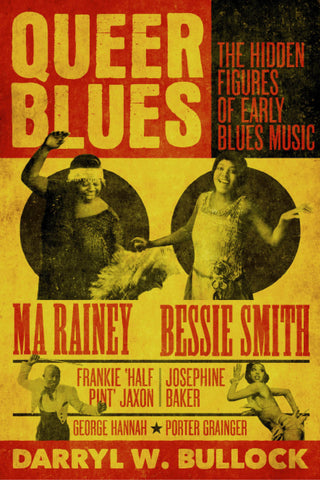
Queer Blues in Britain
Share
Today is publication day for Queer Blues by Darryl W. Bullock, winner of the 2022 Penderyn Music Book Prize for The Velvet Mafia: The Gay Men Who Ran the Swinging Sixties.
Queer Blues is about the musicians - many massive stars in their day - who performed and recorded blues in the 1920s and 1930s. It is an enthralling work of history and music writing, with an extraordinary cast of characters including Ma Rainey, Bessie Smith and Porter Grainger. They combined soulful blues with vibrant performance and direct and explicit lyrics, often with LGBTQ themes and stories. If you haven't read one of Darryl's books before, prepare to be amazed by the level of research and vivid storytelling.
I can't hope to communicate the book's many nuanced and interconnecting stories and themes in a blog but narrowing my focus to Britain helps to introduce some of them. While North America is the setting for the main action in Queer Blues, Britain plays an important role.
In 1923 Blues hopped across the pond in the form of a dance; at first the Brits understood the blues primarily as a dance comparable to the fox-trot. Dance teacher Morry M. Blake left his New York studio and decamped to London to introduce the moves, penning a few instructional paragraphs on it in the press. The dance had staying power perhaps in part because it found royal favour, with the Prince of Wales and his brother the Duke of Kent, both bisexual men, said to be 'so fond of it that they make special requests for it at every ball they attend'.
Prominent Blues artists too were soon taking hold in Britain. American Blues singer Sophie Tucker proved to be a big hit when she performed in London in 1922. She was such a success that in 1926 she sold over a million copies of her recording of 'Some of These Days', an unprecedented number at the time. Indeed, Tucker made such an impression that Paul McCartney's reference to her during the Beatles' Royal Variety Performance in 1963 provoked a perceptive response from the crowd.
American singer and actress Ethel Waters was also a hit. She toured the world in 1929, 'singing the low-down blues... in all the gay capitals of the old world'. She scored big at the London Palladium and at the Cafe de Paris near to Leicester Square; The Reporter described how she 'immediately captivated palladium audiences....'
Darryl explores how the fashion for effeminacy travelled alongside blues and jazz music to Britain, often recorded for posterity through dissaproving voices in the press... One Harley Street physician complained that the British male was now 'a soft, degenerate, spat-wearing, cigarette-smoking mollycoddle...' The 'Pansy Craze' was surging in America at the time, particularly in urban centres like Harlem and San Francisco.
Queer Blues explores the hostility that Black American artists faced at times in Britain, particularly after World War One, including concerns over 'Black artists fraternising with white patrons'. Indeed, Darryl records the shocking fact that the Empire venue announced that it would erect a rail to stop Black musicians leaving the stage.
Staying on the theme of Blues in Britain, check out this wonderful video of American Blues guitarist and singer Sister Rosetta Tharpe performing at a disused railway station in Manchester in 1964.
And why not have a listen to Darryl's playlist for the book.
BOOK LAUNCH INFO
